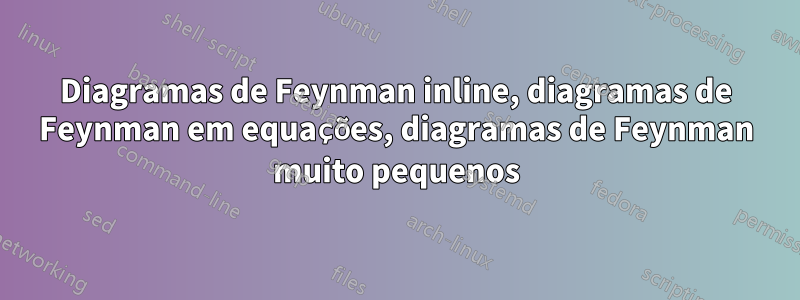
Eu gostaria de escrever equações como:


Eu tentei isso com a biblioteca tikz-feynman, mas os diagramas gerados por ela são muito grandes, mesmo com a opção pequena (e também parecem estranhos). O ideal é digitar diagramas simples, mesmo alinhados com o texto, para evitar a descrição inadequada do diagrama ou o uso de muito espaço e a interrupção do fluxo do documento para exibi-lo.
Responder1
AFAIK você não consegue flechas tortas tikz-feynman. E como você parece não precisar dos algoritmos de desenho de gráfico (e como eles não podem ser carregados no arXv), você pode trabalhar apenas com Ti simpleskZ.
\documentclass[fleqn]{article}
\usepackage{amsmath}
\usepackage{mathrsfs}
\usepackage{tikz}
\usetikzlibrary{arrows.meta,bending,decorations.markings}
% from https://tex.stackexchange.com/a/430239/121799
\tikzset{% inspired by https://tex.stackexchange.com/a/316050/121799
arc arrow/.style args={%
to pos #1 with length #2}{
decoration={
markings,
mark=at position 0 with {\pgfextra{%
\pgfmathsetmacro{\tmpArrowTime}{#2/(\pgfdecoratedpathlength)}
\xdef\tmpArrowTime{\tmpArrowTime}}},
mark=at position {#1-\tmpArrowTime} with {\coordinate(@1);},
mark=at position {#1-2*\tmpArrowTime/3} with {\coordinate(@2);},
mark=at position {#1-\tmpArrowTime/3} with {\coordinate(@3);},
mark=at position {#1} with {\coordinate(@4);
\draw[-{Triangle[length=#2,bend]}]
(@1) .. controls (@2) and (@3) .. (@4);},
},
postaction=decorate,
},
fermion arc arrow/.style={arc arrow=to pos #1 with length 2.5mm},
Vertex/.style={fill,circle,inner sep=1.5pt},
insert vertex/.style={decoration={
markings,
mark=at position #1 with {\node[Vertex]{};},
},
postaction=decorate}
}
\DeclareMathOperator{\tr}{tr}
\begin{document}
\[\mathscr{P}(\varphi)=-\sum\limits_{n=1}^\infty\tr\left(\Delta L_{12}\right)^n
=\vcenter{\hbox{\begin{tikzpicture}
\draw[thick,insert vertex=0,fermion arc arrow={0.55}] (0,0) arc(270:-90:0.6);
\end{tikzpicture}}}+\frac{1}{2}
\vcenter{\hbox{\begin{tikzpicture}
\draw[thick,insert vertex/.list={0,0.5}](0,0) arc(270:-90:0.6);
\draw[fermion arc arrow/.list={0.3,0.8}] (0,0) arc(270:-90:0.6);
\end{tikzpicture}}}
+\frac{1}{3}
\vcenter{\hbox{\begin{tikzpicture}
\draw[thick,insert vertex/.list={0,1/3,2/3}](0,0) arc(270:-90:0.6);
\draw[fermion arc arrow/.list={0.21,0.55,0.88}] (0,0) arc(270:-90:0.6);
\end{tikzpicture}}}+\dots\;.
\]
\[
G(x_1,\dots x_n)=\sum\limits_{m=0}^\infty\frac{1}{m!}
\begin{tikzpicture}[baseline={(X.base)}]
\node[circle,draw,thick,inner sep=2pt] (X) at (0,0) {$n+m$};
\foreach \X in {60,90,120}
{\draw[thick] (\X:0.6) -- (\X:0.9) node[Vertex]{};}
\foreach \X in {-60,-80,-100,-120}
{\draw[thick] (\X:0.6) -- (\X:0.9);}
\node[rotate=-30,overlay] at (-120:1.1){$x_1$};
\node[rotate=30,overlay] at (-60:1.1){$x_n$};
\node at (-90:1.1){$\cdots$};
\end{tikzpicture}
\]
\end{document}



